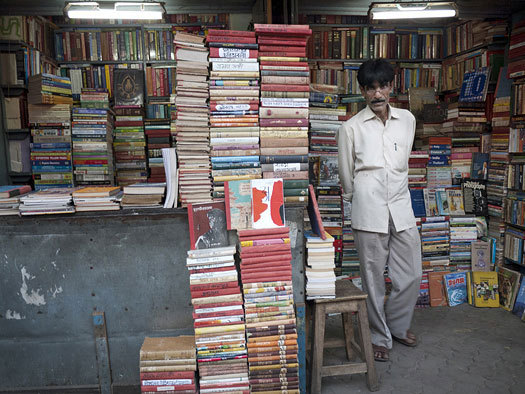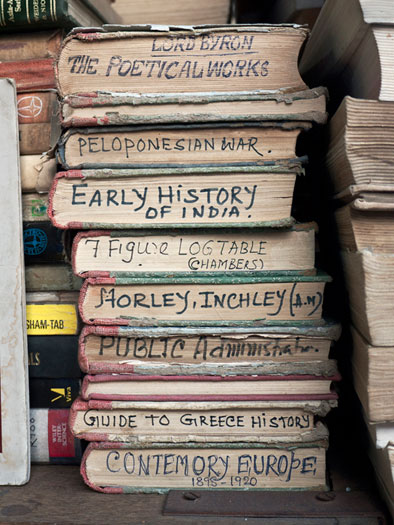
College Street bookseller, Kolkata, 2011
An election is coming in April, and the hammer and sickle is everywhere in Kolkata, formerly Calcutta, a city established by the East India Company and once capital of the British Raj. The Maoist insurgency controls large parts of the countryside just to the west of the city. At the Kolkata Book Fair last month, I find Mao less in evidence than Che, whose iconic image adorns several publishers’ displays, including the Latin American pavilion. Although politics in West Bengal have been dominated by the Communist Party of India (Marxist) since the 1970s, the CPI(M) stands a good chance of losing in April, and there is a sense of apathy in the left-wing bookstalls. At LeftWord Books, an edition of “Karl’s” Capital is 50% off. As I look more closely, I realize that at one display I’m not seeing Che, but Benicio del Toro as Che.
The crowds at the fair pack other bookstalls. At Penguin, families jostle for space around stacks of illustrated books. I’m visiting the book fair with Colin Robinson, a veteran book editor (Verso, Scribner, The New Press) and now co-director of OR Books, an experimental imprint in New York. Colin and I are astounded that books could generate such a fair-ground atmosphere. We each have business in India, but we’re also on holiday from the anxieties of the publishing industry — the death of this, the crisis of that. Here, tens of thousands of people have endured a trip through choked roads to the city outskirts to enjoy a day off among … books. There isn’t an e-reader in sight.
We push through the Penguin display, past a poster of a spectacular Indian model reading Zadie Smith’s On Beauty, and make our way to the U.S. pavilion. For the first time in the fair’s thirty-five years, its theme country is the United States, so the pavilion is something special: an enormous plywood replica of the U.S. Capitol building. Inside are stands with information about the consulate’s American Library and how to visit the U.S. I see only a single bookcase. In it are three dozen books, all face out, most of them Cambridge University Press books on English as a second language. The rest are Obama biographies, Obama picture books, and four or five novels by Richard Ford, who was here the week before to give the fair’s opening address. We leave and head to the British Council’s pavilion. It looks like a good bookshop, shelves crowded with literary classics, British history, books on politics, even scholarly books. We find a Verso book Colin edited more than a decade ago and head outside to celebrate with ice cream.
Colin and I have come to Kolkata in part to visit friends at Seagull Books; Colin is on Seagull’s board, and the University of Chicago Press, for whom I work, distributes Seagull’s titles. Seagull’s publisher, Naveen Kishore, presides also over a bookshop and a gallery carrying the Seagull name. Seagull’s authors now include Tzvetan Todorov, Paul Virilio, Hans Magnus Enzensberger, and Thomas Bernhard, and their books have a distinctive look — the work of Sunandini Banerjee, who designs all of them with her digital collages as jacket art. Passing through Kolkata to visit Seagull this first week of February are also the artist William Kentridge and his wife Anne (for a show of his work in Seagull’s gallery), the anthropologist Rosalind Morris (here to interview Kentridge for a Seagull book), the writer and translator Esther Kinsky (for a reading from her new novel published by Seagull), and Martin Chalmers (translator of Kinsky as well as Enzensberger and others). Every morning, we converge at the Seagull offices, where Naveen, Sunandini, and the rest of the staff are so hospitable that you’d never know they have anything to do but relax with us. In fact, they’re up against Chicago’s deadline for marketing copy, which they will meet, for a fall list of two dozen books.

Poetical Works, College Street, Kolkata, 2011
One afternoon, William, Anne, and I go to the city’s bookselling district, where we have an introduction to Amitava Deb, a book wholesaler with an alleyway shop devoted to English-language books. Amitava takes us to the India Coffee House across the street, once a center of Bengali intellectual life (academics and writers having moved to online solons) and still dominated by a towering portrait of Tagore. At dusk, we push beyond the bookstalls on College Street into a neighborhood of printers, binders, and paper and board factories. It’s soon dark, but work goes on within countless small shops offsetting books, calendars, and business forms. Book blocks printed at one shop, and cases hand-made at another, are hauled by cart to a third closet-sized business — a child with a pot of glue — who will bind them together. Amitava assures me that the printing industry in this district, at least, has not yet taken on international clients. In one shop, William selects three handsome new accountant’s ledgers, potential vehicles for his pastel drawings.
It turns out that Colin and I have a thing for cemeteries. In a video introducing OR Books, he and his partner make a tongue-in-cheek visit to a Manhattan graveyard as the likely destination of commercial publishing’s current business model. We set out one evening for the Park Street Cemetery, the oldest colonial graveyard in the Kolkata. We arrive fifteen minutes after closing and are turned away. Wandering off, we head down a street of primitive auto repair shops, at the end of which we come upon an arched gate with the words “Scottish Cemetery.” It is dusk, but the gate is open, and the caretaker welcomes us in. Before us spread six acres of gothic desolation: broken, sunken, and toppled monuments dating from the 1820s to the 1930s. We clamber across the wrecked graves and read inscriptions until past dark.
Early the next day, I return to photograph the cemetery in Kolkata’s smoky morning light. On one impressive tablet next to the main path is an open book in stone: “Safe in the Arms of Jesus,” it reads. Beneath that are the words, “In loving Memory of Rev. Thomas Jones I. The founding father of the Khasi alphabet and literature and the pioneer of the Welsh Presbyterian mission in Khasi Hills. Died 16th September 1849.” I learn later that Jones is still celebrated in the Khasi Hills of northeast India as “bringer of the book” (a mythology unpacked by historian Andrew May in a fine essay just last year [1]). Accompanying me through the cemetery is its caretaker, a 64-year-old Anglo-Indian named Norman Hall. He tells me about the Kolkata Scottish Heritage Trust, which had recently cleared undergrowth from the cemetery and plans to restore it. Just beyond the cemetery walls are modern apartment blocks, many of them also crumbling. Near the northern wall is one of the most impressive intact tombs, in yellow and red stone. It belongs to William Thomson (died 1868, aged 38) and was “erected by his brother Walter.” “Virtue bears flowers that never decay,” reads the inscription.
For other photographs of Calcutta by Alan Thomas, visit www.alan-thomas.com.
Foot Note
1. Andrew May, “The Promise of a Book: Missionaries and Native Evangelists in North-east India,” in Patricia Grimshaw and Andrew May, eds., Missionaries, Indigenous Peoples and Cultural Exchange (Eastbourne: Sussex Academic Press, 2010), pp. 81-95.
1. Andrew May, “The Promise of a Book: Missionaries and Native Evangelists in North-east India,” in Patricia Grimshaw and Andrew May, eds., Missionaries, Indigenous Peoples and Cultural Exchange (Eastbourne: Sussex Academic Press, 2010), pp. 81-95.



Comments [2]
I was in Calcutta a couple of weeks ago. However, because I was caring for a disabled friend on a tripto India I did not have enough free time to visit The Scottish Cemetery.
I am returning to India later this year and would like to be involved in this project. Should anyone be in a position to point me in the right direction please contact me.
04.16.11
01:41
04.17.11
10:41